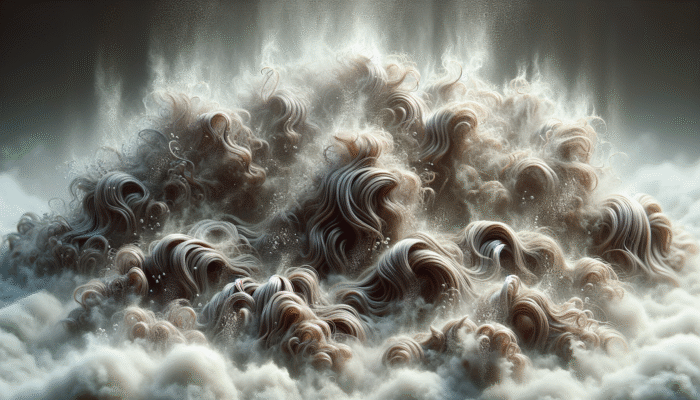Master the Art of Managing Humidity for Gorgeous Wavy Hair
Effectively Dealing with Humidity Issues for Wavy Hair: Individuals with wavy hair often experience the detrimental effects of humidity, which can completely transform the appearance of their carefully styled waves into a frizzy, undefined mess. The interplay between atmospheric moisture and hair structure creates a complex scenario that complicates styling efforts. This section delves into the nuanced relationship between humidity and wavy hair, providing practical insights and actionable strategies to maintain stunning waves, even under the most humid conditions.
Discovering How Humidity Affects Hair Texture

Wavy hair is particularly vulnerable to the influences of humidity. When moisture levels in the air rise, they infiltrate the hair shaft, causing each strand to expand and disrupt its inherent pattern. This expansion not only diminishes hair definition but also leads to increased frizz, creating frustration for anyone seeking a sleek, polished look. By understanding these transformations, individuals can arm themselves with the knowledge needed to effectively confront the challenges posed by atmospheric moisture, enabling more informed styling choices.
In environments with high humidity, the delicate balance of oils and moisture essential for healthy hair gets disturbed. As a result, waves can become unruly, lacking structure and appearing limp. This problem is particularly pronounced in areas known for their high humidity, such as tropical climates or temperate regions during summer months. Gaining insights into how humidity affects hair empowers individuals to devise effective management strategies tailored to these challenging conditions.
To effectively manage wavy hair in humid climates, a fundamental understanding of hair texture science is indispensable. Each hair strand comprises keratin, a protein that imparts strength and elasticity. Increased humidity can undermine this structure, rendering hair more porous and susceptible to frizz. Recognising this enables individuals to select appropriate products that bolster the hair cuticle, aiding in the restoration of control and maintaining sleekness in their waves.
Investigating the Scientific Relationship Between Hair and Humidity
The connection between hair and humidity is deeply embedded in scientific concepts. Hair naturally possesses hydrophilic properties, meaning it readily absorbs moisture from its surroundings. This absorption can alter the curl pattern of hair, often resulting in well-defined waves turning into unpredictable frizz. Grasping this relationship is essential for anyone aiming to preserve the integrity of their hair in humid conditions.
Research reveals that human hair can absorb moisture levels up to 30% of its own weight, leading to considerable swelling and changes in its natural state. This is particularly alarming for those with wavy or curly hair, as uneven expansion of strands can lead to a dishevelled appearance. Understanding how hair reacts to humidity is crucial for crafting effective styling and care methods to mitigate these undesirable effects.
To successfully counteract the adverse impacts of humidity, it is vital to comprehend the chemistry of your hair. Hair porosity plays a significant role in its interaction with moisture. High-porosity hair, often characteristic of wavy and curly types, tends to absorb moisture rapidly, increasing the likelihood of frizz. In contrast, low-porosity hair resists moisture but may struggle to retain adequate hydration for healthy waves. Recognising these traits allows for the development of personalised hair care regimens that effectively alleviate the negative effects of humidity.
Identifying Signs of Elevated Humidity Levels
Recognising the indicators of heightened humidity is crucial for adjusting your hair care routine effectively. Various signs can indicate that the atmosphere is saturated with moisture. Weather forecasts frequently provide humidity percentages, which can guide your preparations for the day ahead. A reading exceeding 60% typically signifies a humid environment, suggesting that an adjustment to your hair care routine is in order.
Individuals can also observe their hair’s response to shifts in humidity. The emergence of frizz and a loss of definition are common early warning signs that it’s time to adapt your regimen. Environmental cues, such as a sticky atmosphere or discomfort outdoors, can also suggest increased moisture levels. By recognising these signs, you can proactively manage wavy hair in humid climates and prepare accordingly.
This proactive strategy may involve altering your choice of products or styling techniques, ensuring that you are well-prepared to tackle the challenges humidity poses to your hair.
Key Daily Hair Care Routines to Thrive in Humid Conditions

Establishing a comprehensive daily hair care routine is vital for preserving the health and appearance of wavy hair in humid environments. Each step, from morning to night, must be meticulously planned to address the unique challenges presented by moisture-rich air. This section details practical and effective routines designed to keep your waves vibrant and manageable throughout the day, ensuring they look their absolute best.
Morning Hair Care Techniques for Optimal Control
Initiating your day with a thorough hair care regimen is crucial for counteracting the effects of humidity. Start by selecting a hydrating shampoo specifically formulated to lock moisture into the hair while repelling excess humidity. Opt for products enriched with natural oils, such as argan or jojoba oil, which can help maintain your hair’s natural wave pattern and enhance overall health.
Following shampooing, apply a conditioner that provides deep hydration without weighing your hair down. Pay special attention to the mid-lengths and ends, the areas where hair tends to be drier and more susceptible to damage. This targeted approach nourishes your wavy locks and prepares them effectively for styling, ensuring your waves retain their definition and vitality throughout the day.
Additionally, consider incorporating a pre-styling product, such as a heat protectant or an anti-frizz serum, into your morning routine. These products create an extra barrier against humidity, aiding moisture retention and safeguarding the hair’s structure. A well-rounded morning routine sets the stage for the day ahead, ensuring your waves can withstand humidity without succumbing to frizz and chaos.
Midday Strategies for Maintaining Well-Defined Waves
As the day progresses, it’s essential to remain vigilant about preserving your waves amidst humidity. Carrying a travel-sized anti-frizz product can prove invaluable for those grappling with persistent humidity throughout the day. A light mist or serum can help refresh your style and control any emerging frizz, allowing you to uphold a polished and put-together look.
When applying product, focus on the areas that require the most attention—typically the crown and the tips of your hair. Avoid applying too much product all at once; instead, layer it gradually for optimal results. This technique ensures that your waves stay defined without appearing greasy or burdened by excess product.
Furthermore, be mindful of your surroundings. If you find yourself in an excessively humid area, seek shaded locations or indoor environments with air conditioning. Steering clear of direct sunlight and extreme heat can significantly aid in preserving the integrity of your hairstyle, ensuring your waves remain at their best throughout the day.
Evening Hair Care Practices to Revitalise Wavy Hair

As the day comes to a close, the focus shifts to restoring and preparing your wavy hair for the next day. Incorporating a leave-in conditioner into your evening routine can significantly reduce frizz and maintain hydration overnight. Look for formulations infused with natural oils and proteins to strengthen your hair while you sleep, ensuring you wake up to healthy, manageable waves.
After applying the leave-in conditioner, gently detangle your hair using a wide-tooth comb. This practice helps prevent breakage and ensures even product distribution throughout your strands. Emphasising this step is vital, as it not only assists with moisture retention but also promotes healthier, more vibrant waves in the long run.
Consider braiding your hair or securing longer locks in a loose bun before bedtime. This protective styling reduces friction during sleep and helps maintain your hair’s natural wave pattern, allowing you to wake up with beautifully defined waves ready to shine.
Nighttime Protection Techniques to Guard Against Humidity
Nighttime care is critical for safeguarding the health of your wavy hair. One of the most effective strategies involves using a silk scarf or pillowcase. The smooth texture significantly reduces friction during sleep, minimising frizz and protecting your hair’s moisture levels. Unlike traditional cotton, which can absorb moisture, silk helps retain hydration, making it an ideal choice for those managing wavy hair in humid climates.
When wrapping your hair, ensure it is loosely secured to avoid tension on the scalp. This practice not only protects your hair but also encourages healthy growth by reducing stress on the follicles. If a scarf isn’t your preference, investing in a silk pillowcase can provide similar benefits without requiring additional effort.
Integrating these nighttime protection strategies into your routine can lead to more manageable and healthier waves. The combination of moisture retention and reduced friction ensures that you wake up ready to face the challenges of humidity with confidence.
Choosing the Best Products for Wavy Hair in Humid Climates
The selection of suitable products can greatly enhance your success in achieving beautiful, well-defined waves in humid environments. It is crucial to choose hair care items that complement your hair type and effectively tackle the challenges posed by moisture. This section explores the key products you should consider incorporating into your hair care routine for optimal results.
Selecting Premium Shampoo and Conditioner for Humidity Control
The foundation of any effective hair care routine lies in the choice of shampoo and conditioner. For individuals with wavy hair facing humidity challenges, opting for products with anti-frizz properties is essential. Choose shampoos free from sulfates, as these can strip moisture from your hair, exacerbating frizz and negatively impacting overall health.
Conditioners should focus on hydration and smoothing ingredients. Products infused with keratin, shea butter, or coconut oil provide essential nourishment while helping to seal the hair cuticle. This sealing effect is vital when combating humidity-induced swelling, allowing your waves to maintain their shape and definition effectively.
Consider your hair texture when selecting products. Individuals with thicker, coarser waves may benefit from richer hydrating formulas, while finer hair types might require lighter options. Tailoring your product selection to your specific hair needs can significantly enhance your ability to manage wavy hair effectively in humid climates.
The Essential Function of Leave-In Conditioners for Wavy Hair
Leave-in conditioners are critical for maintaining moisture levels and combating frizz throughout the day. These products offer continuous hydration, making them indispensable for wavy hair in humid environments. Seek leave-in conditioners containing ingredients such as aloe vera or glycerin, which help attract and retain moisture within the hair.
Incorporating a leave-in conditioner into your routine enables you to preserve your hair’s health while enhancing its natural texture. Apply it post-washing, focusing on the mid-lengths and ends. This approach aids in defining your waves while preventing frizz from taking over as humidity levels rise throughout the day.
For added protection in extreme humidity, consider pairing your leave-in conditioner with a styling cream or gel that offers hold. This combination helps manage frizz while allowing you to shape and define your waves, providing a polished appearance that endures.
Choosing Effective Styling Products to Tackle Frizz
Selecting the appropriate styling products is crucial for achieving defined waves in humid conditions. Opt for lightweight gels or creams that provide hold without weighing your hair down. Look for products that advertise anti-humidity properties, as they can effectively shield your waves from moisture in the air, helping to maintain their structural integrity.
When applying styling products, utilise a technique known as “scrunching.” This method enhances your natural waves while ensuring even product distribution. Begin by applying some product to damp hair, then scrunch upwards toward your scalp. This action encourages wave formation and can significantly reduce frizz.
Experimentation with various products is key to discovering the best fit for your hair type. Some may find that mousses or foams yield better results for their waves, while others might prefer the control offered by creams. The world of styling products is vast, so take your time to explore different options until you find the ideal combination for managing wavy hair in humid climates.
Creative Styling Techniques for Wavy Hair in Humid Conditions
Styling wavy hair in humid conditions requires skill and creativity. A variety of techniques can assist you in achieving a controlled, polished appearance that withstands moisture. This section will explore effective styling methods that enhance your waves while minimising frizz and chaos.
Evaluating the Benefits of Air-Drying Versus Heat Styling
The choice between air-drying and heat styling can profoundly influence your hair’s ability to combat humidity. Air-drying allows your natural waves to form freely but may necessitate additional products to counter frizz. Conversely, heat styling offers a more controlled method, enabling you to create defined waves that are less prone to humidity-induced disruptions.
When air-drying, dampen your hair with a leave-in conditioner or anti-frizz product. This helps seal moisture within the hair shaft while defining your waves. It’s crucial to let your hair dry completely before touching or styling it further, as premature handling can lead to frizz.
If you choose heat styling, always apply a reliable heat protectant to shield your hair from potential damage. Tools such as curling wands or flat irons can create beautifully defined waves that are less susceptible to frizz in humid conditions. However, moderation is key—excessive heat styling can lead to long-term damage, making balance essential for preserving healthy waves.
Chic Hairstyles for Humid Days
On particularly humid days, opting for protective hairstyles can save the day. Styles such as braids, buns, or updos keep hair off your neck and limit exposure to moisture in the air. These styles not only maintain a polished look but also offer comfort in sticky conditions, allowing you to navigate your day with ease.
Consider a loose braid or messy bun, which can effortlessly embrace your hair’s natural texture while keeping it secure. These styles are versatile enough to suit various occasions, from casual outings to more formal events, ensuring you look chic and feel comfortable.
In addition, incorporating hair accessories can elevate your look while providing functional benefits. Headbands or decorative pins can help manage stray hairs, contributing to a more refined appearance. By strategically selecting hairstyles that minimise frizz, you can enjoy your day without the persistent worry of humidity taming your beautiful waves.
Ensuring Your Hairstyle Remains Intact All Day
To guarantee your hairstyle remains intact throughout the day, utilise light hairsprays or texturising sprays designed to combat humidity. These products help lock in your style while creating a barrier against moisture in the air. After styling, apply a light mist to secure your waves without producing a stiff or crunchy finish.
Consider carrying a small travel-sized version of your preferred styling product for quick touch-ups. A few spritzes can make a significant difference in refreshing your waves and controlling any frizz that may develop during the day.
Moreover, remember that a well-planned hairstyle can significantly influence your overall look. Opting for styles that require minimal upkeep, such as loose waves or a half-up, half-down style, can help you maintain your desired appearance while allowing you to focus on enjoying your day without constant hair adjustments.
Choosing the Right Hair Products for Optimal Management
Selecting the appropriate hair products tailored to your specific hair type is crucial for effectively managing waves in humid conditions. Look for curl creams that define waves while providing moisture and hold. These products enhance your hair’s natural texture, ensuring your waves remain accentuated rather than succumbing to frizz and disarray.
When shopping for styling products, consider your hair’s porosity and thickness. Thicker, coarser hair may benefit from heavier creams or gels, while finer hair types might find that lightweight mousses work better for their needs. Experimentation is essential, as finding the right products can dramatically improve your ability to manage wavy hair in humid climates.
Additionally, don’t hesitate to read reviews and seek recommendations from others with similar hair types. Personal experiences can guide you toward effective products that have yielded positive results for others, helping you navigate your hair care journey with confidence and assurance.
Defending Wavy Hair Against Humidity Damage
Humidity can wreak havoc on wavy hair, leading to frizz, dryness, and overall damage if not managed properly. Employing protective strategies is essential for preserving the health and appearance of your waves. This section explores effective methods to safeguard your hair from the adverse effects of humidity.
Preventing Loss of Moisture from Hair
To combat humidity-related damage, it is crucial to prevent moisture loss from your hair. Utilise hydrating products that seal in moisture while providing a protective barrier against humidity’s effects. Seek moisturising shampoos, conditioners, and styling products that contain ingredients such as coconut oil, glycerin, and shea butter, which are effective in locking in hydration and maintaining hair health.
Incorporating a weekly deep conditioning treatment into your routine can significantly aid in combating moisture loss. These treatments deliver intense hydration, allowing your hair to maintain moisture more effectively and counteracting the drying effects of humidity.
Moreover, be mindful of external factors that contribute to dryness, such as sun and wind exposure. Wearing a hat or scarf can protect your hair from these elements, ensuring your waves remain healthy and hydrated even in challenging weather conditions.
Minimising Heat Damage to Wavy Hair
While heat styling can provide immediate control over your waves, excessive use of heat tools can result in long-term damage, particularly in humid conditions. To minimise heat damage, restrict your use of blow dryers, curling wands, and straighteners, opting instead for gentler styling methods whenever possible.
When you do choose to style with heat, apply a reliable heat protectant first to create a barrier between your hair and the high temperatures. This precaution is especially important for individuals with wavy hair, as humidity may already compromise the cuticle, making it more susceptible to damage.
Consider alternative styling methods that do not require heat, such as braiding damp hair or using foam rollers to achieve defined waves. These techniques can yield beautiful results without the potential harm associated with excessive heat styling, preserving the integrity of your hair.
Regular Trimming for Maintaining Healthy Waves
To maintain your waves, regular trimming is essential to prevent split ends. Split ends can exacerbate the effects of humidity by making your hair appear frizzy and unkempt. Scheduling trims every 6-8 weeks ensures that your hair remains healthy and vibrant, helping to preserve the natural texture of your waves and enhancing their overall appearance.
Communicate your specific hair type and goals with your stylist. A professional can recommend the best cutting techniques to enhance your waves while preventing damage. Regular maintenance fortifies your hair against the challenges posed by humidity, allowing you to enjoy luscious waves year-round.
Long-Term Strategies for Sustaining Wavy Hair Health
Achieving healthy, manageable wavy hair in humid climates necessitates a commitment to long-term care. Establishing a comprehensive routine that addresses various aspects of hair health is vital for maintaining your waves under challenging conditions. This section outlines effective strategies that promote lasting health and vibrancy in your wavy hair.
Establishing a Consistent Hair Care Routine for Wavy Hair
Building a well-structured hair care routine tailored to your wavy hair is essential for successfully navigating humid climates. Start by identifying products that cater to your specific hair type and needs, with an emphasis on hydration and anti-frizz properties. Create a regimen with gentle cleansing and nourishing conditioners to effectively maintain moisture levels.
Incorporate regular deep conditioning treatments into your routine, aiming for once a week or bi-weekly depending on your hair’s specific needs. This step is crucial for keeping your waves hydrated, especially in humid conditions where moisture retention is key to maintaining hair health.
Remember that consistency is paramount. Stick to your routine and allow your hair time to respond to your chosen products and methods. Over time, you will likely observe improvements in the health and manageability of your waves, leading to a more confident you.
Nutritional Support for Enhanced Hair Vitality
A balanced diet plays an integral role in hair health. Nutrients such as vitamins A, C, D, E, biotin, and omega-3 fatty acids contribute to hair strength and vitality. Including foods rich in these nutrients can enhance your hair’s resilience against humidity and promote overall health, leading to beautiful waves.
Consider incorporating avocados, nuts, seeds, leafy greens, and fatty fish. These foods provide essential fatty acids and antioxidants that encourage hair growth and combat dryness, ensuring your waves remain beautiful and manageable.
Stay hydrated as well. Drinking plenty of water supports overall body function and helps keep your hair hydrated from within. A healthy diet and proper hydration can significantly impact the appearance and manageability of wavy hair in humid climates, so prioritise your nutrition for optimal hair health.
Adapting to Fluctuating Humidity Levels
Adjusting hair care products and routines in response to varying humidity levels is vital for maintaining healthy waves. Keep an eye on the weather patterns in your area, as fluctuations in humidity can dictate your approach to styling and care. This adaptability is crucial for achieving the best results for your hair.
Consider using heavier products that offer extra moisture and protection during particularly humid days. Conversely, on drier days, lightweight products may be more appropriate to avoid buildup and ensure your hair remains buoyant and lively.
Experimenting with different products in response to humidity changes allows you to create a flexible routine that caters to your hair’s unique needs. This adaptive approach helps combat humidity’s unpredictable nature, ensuring that your waves remain stunning and manageable regardless of the weather.
Incorporating Protective Styles for Hair Well-Being
Exploring protective hairstyles can be incredibly beneficial for maintaining the health of your wavy hair. Styles such as braids and buns help minimise damage caused by environmental factors and reduce exposure to humidity, ensuring your hair remains in optimal condition.
Integrating protective styles into your routine can promote hair growth by reducing tension and breakage. Look for styles that allow your waves to shine while offering protection, such as loose braids or wrapped buns that keep your hair secure yet stylish.
Moreover, consider using silk or satin accessories to reduce friction when wearing protective styles. These materials minimise frizz and help maintain moisture levels, ensuring your waves stay healthy and vibrant even under challenging conditions.
Regular Trimming to Sustain Healthy Waves
Maintaining healthy waves in humid climates requires a commitment to regular trimming. Scheduling trims every 6-8 weeks is essential for preventing split ends and ensuring that your hair remains in optimal condition. Regular haircuts not only remove damaged ends but also encourage healthier growth and enhance the overall appearance of your waves.
Discuss your goals with your stylist, who can recommend the best cutting techniques for your specific hair type. Regular trims fortify your hair against the challenges posed by humidity, allowing you to enjoy the beauty of your waves without worrying about damage or frizz.
Your Questions Answered: Managing Wavy Hair
What are the best strategies to prevent frizz in humid weather?
To effectively prevent frizz, utilise anti-frizz products, hydrating shampoos, and conditioners. Embrace protective styles and limit your use of heat styling tools to maintain your hair’s integrity.
Which ingredients should I focus on in products for wavy hair?
Look for products enriched with natural oils, glycerin, and proteins. Ingredients like argan oil and shea butter are particularly beneficial for hydration and maintaining wave definition.
Is air-drying better than heat styling for wavy hair?
Air-drying is generally gentler on the hair and allows natural waves to develop freely. While heat styling can offer immediate control over your style, it should be used sparingly to prevent damage.
How often should I trim my wavy hair for optimal health?
Trimming every 6-8 weeks is recommended to prevent split ends and maintain the health and beauty of your waves.
Can my diet affect my hair’s response to humidity?
A balanced diet rich in essential vitamins and omega-3 fatty acids supports hair health and improves resilience against humidity and environmental stressors.
What are some effective protective hairstyles for wavy hair?
Styles such as braids, buns, and updos are excellent choices for keeping hair off the neck and reducing exposure to humidity, thus preserving waves.
Should I include a leave-in conditioner in my daily routine?
A daily leave-in conditioner can help maintain moisture levels and manage frizz, particularly in humid conditions.
How do I determine if it’s too humid for my hair?
If your hair tends to frizz easily or lose shape quickly, it’s likely a sign of high humidity. Monitoring humidity levels in weather forecasts can help you prepare your hair care routine better.
Are there specific styling techniques I should apply on humid days?
Opt for hairstyles that minimise hair exposure to humidity, such as braids or buns, and use light hairsprays to secure your style against moisture.
Is it necessary to adapt my hair products based on humidity levels?
Adjusting your hair products to suit humidity levels can greatly enhance manageability. Consider using heavier products during humid days for extra moisture and protection.
Connect with us on Facebook!
This article: Managing Wavy Hair in Humid Climates: Essential Tips appeared first on Amitys Hair Salon.
This article Managing Wavy Hair: Essential Tips for Humid Climates was found on https://limitsofstrategy.com.
The Article Wavy Hair Management: Key Tips for Humid Weather found first on https://electroquench.com

